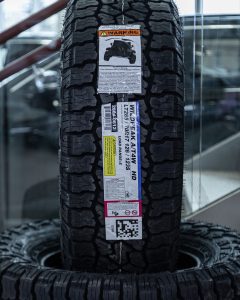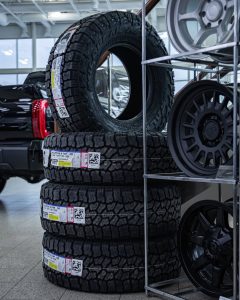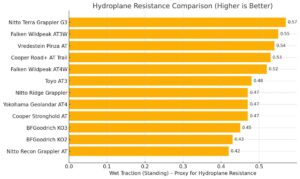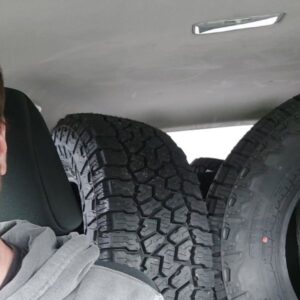As a former Bridgestone field test engineer, I see the same dilemma over and over: Wildpeak AT Trail vs AT3W vs AT4W. They share a name, but they’re built for different drivers. The simplest way to pick the right one is to start from your size and vehicle type, then match performance priorities (winter, comfort, towing, off-road). This guide does exactly that—then gives you quick recommendations you can act on.
Important Note on the AT3W Legacy:
You may have searched for the discontinued Falken Wildpeak AT3W. While production has ceased, some closeout stock is still available. This comparison is based on some popular-sized sized can still be found on retailers like Tire Rack:
Click here for the Full Technical Breakdown: AT4W vs Discontinued AT3W Test Results
Quick Take
The Falken Wildpeak lineup splits into three very different personalities. The AT Trail is designed for crossovers and SUVs first — it’s quiet, composed, and light off-road capable, making it the best choice if you want the A/T look without sacrificing daily comfort. The AT3W, while traditionally seen as a light-truck A/T, is also a smart pick for SUV and CUV owners in snow belt regions who want real winter performance, thanks to its 3PMSF certification and dense siping. It balances road manners with credible traction on dirt and snow, offering a more “planted” feel than the Trail. The new AT4W pushes deeper into truck territory — tuned for towing stability, heavier loads, and rocky terrain, it feels more locked-in at speed but rides firmer than the other two.
Falken Wildpeak AT Trail
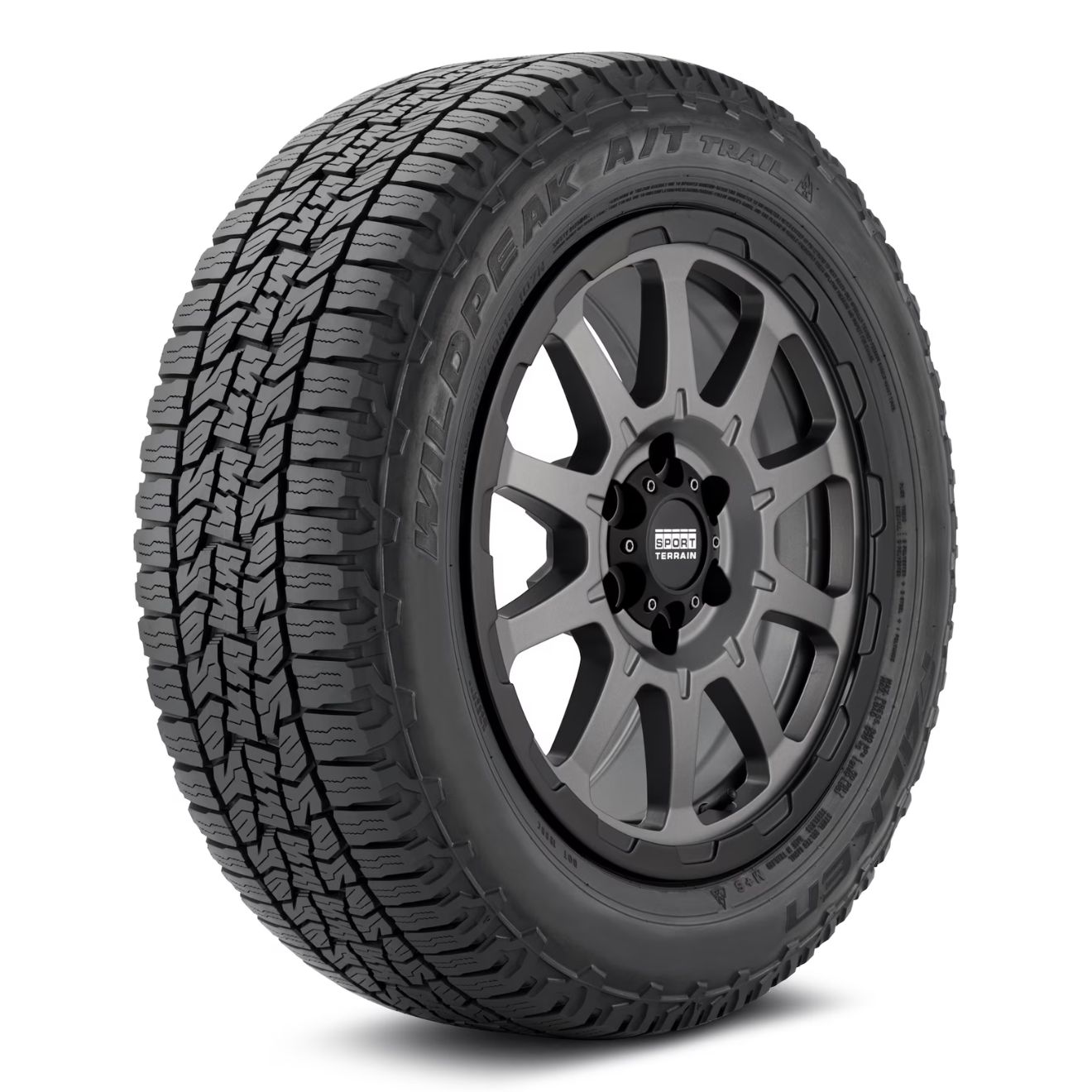
Falken Wildpeak A/T4W
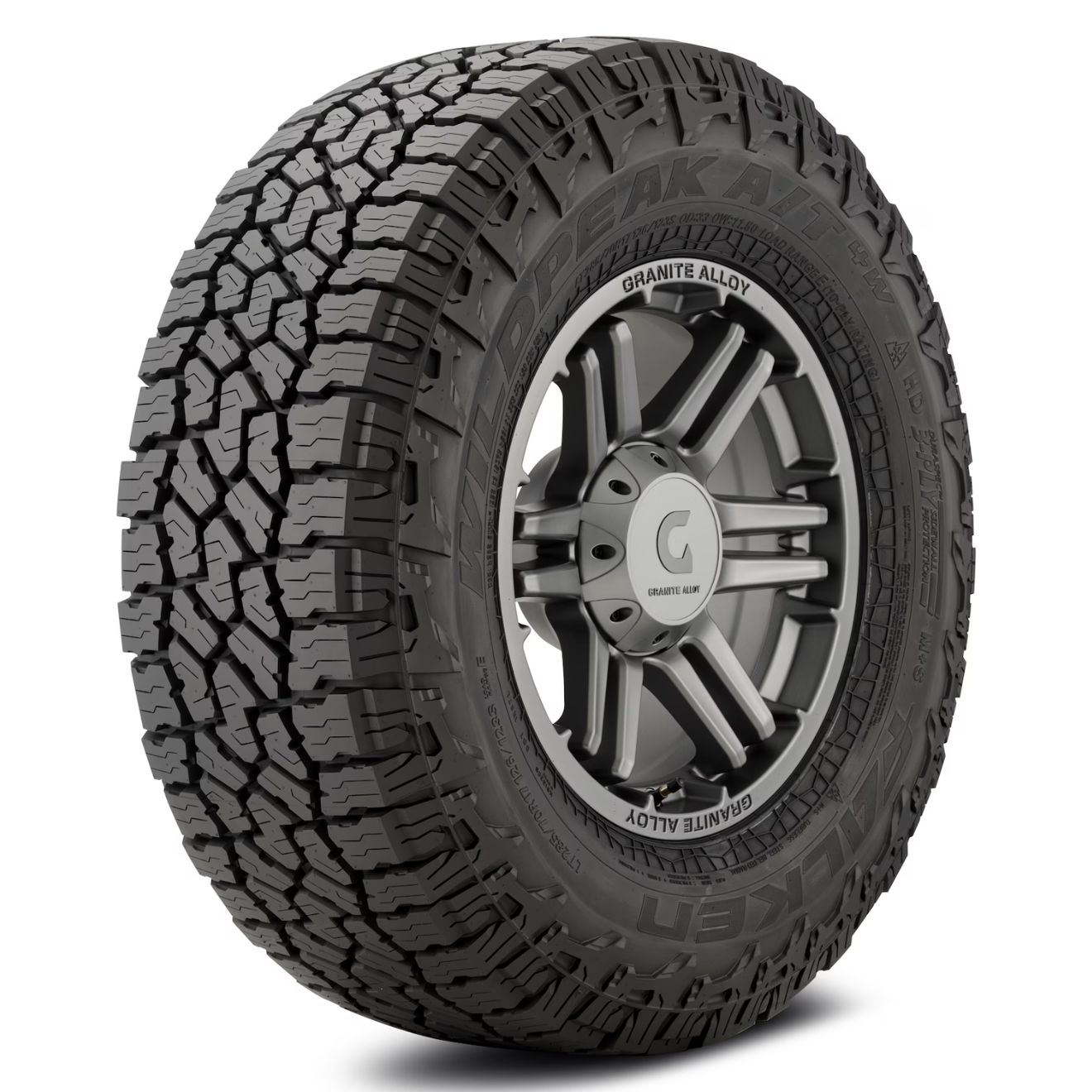
Tire Decision Tool
For those in a hurry: this tool makes it easy. Just pick your vehicle and what matters most to you, and it’ll instantly suggest the best tire options.
225/65R17 — Compact & Mid SUVs (RAV4, CR-V, Forester, CX-5)
Availability & Fitment
In this size, Falken splits the lineup in an interesting way. The AT Trail comes in an SL load rating at 31 lbs, making it light and efficient — a natural fit for smaller crossovers that don’t need reinforced sidewalls. The AT4W is also offered in 225/65R17, but only in XL load rating at 35 lbs, which adds toughness for off-road but also a bit more rolling resistance. The AT3W isn’t officially sold in this exact size anymore, though Falken does offer a special edition 235/65R17 in SL load (31 lbs), which some SUV owners in snow-heavy regions still seek out for its winter traction.
Daily Ride & Handling
For everyday driving, the AT Trail feels closest to stock — quiet, smooth, and quick to settle in lane changes. The AT4W rides firmer thanks to its XL build, but that stiffness translates into better stability when loaded or aired down. Drivers who spend most of their time on pavement will notice the Trail’s refinement, while the AT4W carries a bit more weight in the steering wheel.
Winter & Snow
This is where the AT3W’s special edition size still matters. If you’re in the snow belt and prioritize winter grip, the AT3W remains the reference point, with its 3PMSF badge and dense siping. The AT Trail is fine for light snow, while the AT4W provides good bite but leans more “truck-like” in feel, prioritizing carcass stability over soft-road grip.
Light Off-Road / Gravel Roads
The AT Trail is comfortable on forest roads and gravel — think fire roads, mild camping access, or light exploration. The AT4W’s XL build gives it more bite and stability on rougher tracks, but you’ll pay for it at the pump with a slight mpg hit compared to the Trail.
👉 Verdict: For compact and mid-SUVs, the AT Trail is the best everyday choice if you value comfort and efficiency. If you live in a snow-heavy region, hunting down the AT3W in 235/65R17 SL is still worthwhile for real winter confidence. If you want extra toughness and don’t mind a firmer ride with slightly worse mpg, the AT4W in XL is the right upgrade for mild off-road use.
255/65R18 — Bigger SUVs (Explorer, 4Runner, Highlander)
Availability & Fitment
In this size, buyers have three paths. The AT Trail is offered in SL load at 42 lbs, tuned for comfort and daily efficiency. The AT4W comes only in XL load at 42.4 lbs, with deeper tread (13/32”) and higher pressure capacity (50 PSI), making it tougher and more stable. The AT3W isn’t available directly in 255/65R18, but some SUV owners upsize to 285/65R18 if they want its proven winter traction and burlier construction.
Daily Ride & Stability
The AT Trail rides closest to stock — smoother, quieter, and easier on mpg. The AT4W feels firmer and more “locked in” at speed, giving extra confidence in highway crosswinds and when carrying gear. That stability, however, comes with a small fuel economy trade-off compared to the lighter Trail.
Winter & Snow
The AT3W isn’t available in this size anymore, so it’s only an option if you upsize to 285/65R18 — a move some snow-belt SUV owners still make for its outstanding winter grip. For drivers sticking with 255/65R18, the AT4W is the stronger choice for harsher winter use, offering dependable traction and stability even in challenging conditions, though it carries a more truck-like feel. The AT Trail can handle light winter duty just fine, but it doesn’t inspire the same confidence once snow piles up or roads turn icy.
Off-Road / Gravel & Rock
Here the AT4W is the clear winner. Its XL build and shoulder geometry give it more bite and composure when aired down on rocky or rutted surfaces. The AT Trail handles forest roads and light gravel without issue, but it isn’t designed for sustained off-road punishment.
👉 Verdict: For bigger SUVs, the AT Trail is the comfort-focused choice if your driving is mostly highway and city. The AT4W is the tougher option for towing, hauling, and rougher terrain, though it costs a bit of mpg. And if you’re in a snow belt and willing to upsize, the AT3W in 285/65R18 remains Falken’s best winter performer.
LT265/70R17 — Trucks (Tacoma, 4Runner, F-150, Wrangler)
Availability & Fitment
In this core truck size, only the AT4W is offered. The AT3W isn’t built in 265/70R17 anymore, and the AT Trail never scaled to LT construction. If buyers want the AT3W, they’ll need to step out of stock sizing:
Downsize: 265/65R17 (−3%) → works fine, slightly less clearance.
Upsize: 275/70R17 (+3%) → popular choice, minimal trimming needed.
Aggressive: 285/70R17 (+3.5%) → requires leveling/lift, but unlocks AT3W availability.
Daily Ride & Stability
The AT4W’s firmer carcass and XL/LT build make it more planted under load — especially when towing, hauling, or dealing with highway crosswinds. Downsizing or upsizing into the AT3W gives a slightly softer ride, but that means stepping outside factory spec.
Winter & Snow
For stock 265/70R17, the AT4W handles winter well enough, though its tuning leans more toward stability than soft-road grip. Buyers in the snow belt who want the AT3W’s legendary 3PMSF bite will need to resize into 265/65R17, 275/70R17, or 285/70R17.
Off-Road / Gravel & Rock
The AT4W is the go-to here, with its reinforced shoulders and stability when aired down. The AT3W is still excellent off-road — but only if you make the size jump.
👉 Verdict: If you’re sticking to LT265/70R17, AT4W is your only choice — and it’s built for stability, towing, and rocky trails. Winter-focused buyers can resize into an AT3W, with minor adjustments depending on whether they go downsize (265/65R17) or upsize (275/70R17, 285/70R17).
285/65R18 — Trucks & SUVs on 18s (Silverado, F-150, Ram 1500, etc.)
Availability & Fitment
This is the size where the AT3W and AT4W directly compete. Both are offered, giving buyers a true choice. The AT Trail is not produced in this LT truck fitment.
Daily Ride & Stability
The AT3W rides softer and more compliant, making it the better choice for trucks that split commuting and light off-road. The AT4W is firmer and more stable under towing or heavy payloads, especially noticeable in highway sweepers and crosswinds.
Winter & Snow
The AT3W is still the benchmark for winter traction among Falken’s A/Ts, thanks to its siping density and 3PMSF certification. The AT4W narrows the gap, performing well but with a more truck-like feel.
Off-Road / Gravel & Rock
The AT4W is the tougher choice for rocky and technical trails, with stronger casing support and better stability when aired down. The AT3W handles dirt and gravel easily, but doesn’t feel as bulletproof in harsher conditions.
👉 Verdict: In 285/65R18, buyers finally get a real choice. For winter traction and smoother daily driving, pick the AT3W. For towing, payload, and rocky off-road confidence, go with the AT4W.
265/60R18 — Light Trucks & Larger SUVs
In this size, the Wildpeak AT4W is your only option, and it’s a good one. With its XL/LT construction, it covers everything from towing and payload stability to rocky trail use, while still handling daily highway duty confidently. If you run 265/60R18 stock, the AT4W matches all needs without compromise — there’s no AT3W in this exact size, and the AT Trail doesn’t apply.
👉 Verdict: Stick with the AT4W here. It’s built to handle the full mix of truck and SUV demands.
Head-to-Head by Condition
| Condition | Wildpeak AT Trail CUV/SUV | Wildpeak AT3W Winter/Balance | Wildpeak AT4W Truck/Load |
|---|---|---|---|
| Dry & Wet Roads | Most comfortable and quiet; tuned for CUV/SUV daily pavement use. | Balanced manners; a bit more A/T presence but good grip in both dry and wet. | Firmer and more “locked-in,” especially under load; best for towing stability. |
| Winter & Snow | Fine for light winter use; not as secure in heavy snow/ice. | Wildpeak benchmark for snow/slush (3PMSF + siping density). | Close behind AT3W; dependable snow traction with a truck-tuned feel. |
| Off-Road (Gravel/Rock/Mud) | Forest roads, fire trails, mild gravel. | Capable on dirt and light trails; good for casual off-roaders. | Leader on rocky/rutted terrain; tougher carcass & shoulders; better aired down. |
| Comfort & Noise | Quietest and smoothest; closest to a stock highway tire. | Middle ground — comfortable daily, some A/T hum. | Firmest and noisier; trades softness for loaded stability and control. |
What Drivers Say
AT Trail (CUV/SUV)
“They’re very quiet, and the ride… is in no way harsh.” subaruoutback.org
“Lost 1–2 mpg in a larger size… quiet. Note these are the TRAILS.” rav4world.com
“Overall… very pleased… my only complaint is tread wear appears faster than stock.” subaruforester.org
AT3W (Balanced + Winter)
“I changed to Wildpeak AT3W… better wet traction… better dirt and mud… no regrets.” cumminsforum.com
“I’ve never had problems in the snow with them… from 5°F to deep snow.” Tacoma World
(Counterpoint) “Off-grid in the Cascades… disappointed by winter performance.” Reddit
AT4W (Truck/Load)
“For being A/T tires, they’re very quiet… excellent so far on dry highway.” Reddit
“Better durability, towing stability, on-road handling, and treadlife than AT3W.” (owner discussion) forum.ih8mud.com
“When towing I like the extra weight… don’t feel the wind or trucks as much.” Facebook
Final Verdict
When choosing between the AT Trail, AT3W, and AT4W, it comes down to your vehicle type, climate, and how much weight or off-road abuse you throw at your tires.
AT Trail is the comfort-first choice for CUVs and SUVs that want the all-terrain look without the trade-offs. It runs smooth and quiet, but tread life won’t match the heavier-duty AT4W if you load it down or live on gravel.
AT3W remains the winter benchmark in the Wildpeak family, with proven snow and slush performance. While it’s being phased out of some stock SUV and truck sizes, it’s still worth considering if you’re in the snow belt and willing to upsize.
AT4W is Falken’s modern truck/all-terrain workhorse. It feels more stable under towing, carries heavy payloads without squirm, and brings extra off-road bite. The trade-off is a firmer ride and a small hit to mpg compared to the lighter AT Trail.
👉 Size & Load Note:
AT Trail = P-metric/SL & XL SUV sizes (lighter, efficiency-focused).
AT3W = still available in broader P/XL/LT sizes, but shrinking in some key SUV/truck fitments — often an upsize option now.
AT4W = built around modern LT truck sizes with XL or LT load ranges, making it the go-to if stability and load are priorities.
Bottom line:
Daily driver SUV with mild winters → AT Trail.
SUV/Truck in snow belt, or drivers who want year-round balance → AT3W.
Truck owners who tow, haul, or hit tougher trails → AT4W.
